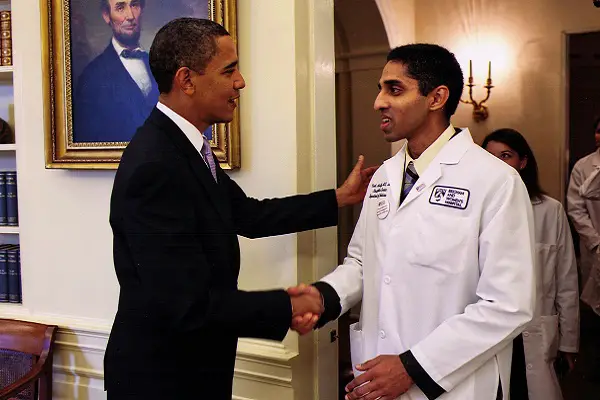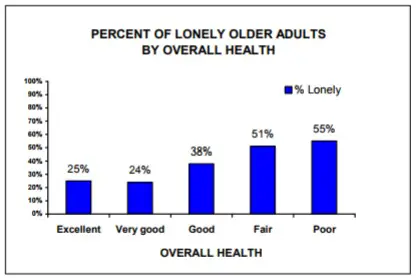
PHOTO: www.justkannada.in
When we think of health epidemics in the U.S., we often think of obesity, depression, and chronic disease.
But there is one critical underlying health issue in all of these epidemics that we rarely talk about. This issue is an epidemic of loneliness, one that has been highlighted more than ever before in this era of social distancing, masks and quarantines among the general population.
Former surgeon general Dr. Vivek Murthy, who was just nominated as presidential-elect Joe Biden’s pick for surgeon general, was appointed to the same post by former president Barack Obama in 2014, three years he served on the U.S. Presidential Advisory Council on Prevention, Health Promotion, and Integrative and Public Health.
In 2017, he shared his conclusions about the state of health of American people, delivering a timeless and crucially important message about loneliness and isolation that as many people as possible would do well to hear in the era of social distancing and lockdown orders that seem endless.
Facts about Loneliness in the 21st Century
It is to no one’s surprise that we, as society, have grown more and more disconnected. With the growing use of technology and social media, there are now more excuses than ever to not speak to people around us, at work, on the street, and even at social gatherings.
As Dr. Murthy pointed out in his Harvard Business Review report, people still come together in crisis and when tragedies strike. But when life is going at its normal pace, we forget about one another. With this social disconnect, the feeling of loneliness has impacted many, and has actually doubled since the 1980s.
How many of us feel isolated from others?
The American Association of Retired Persons (AARP) surveyed people over the age of 45 in 2010 and found out that at least 35% were lonely, and almost half of these people felt lonely for over 6 years.
The percentage fell with age according to the AARP survey. In the 70 and older age group, 25% reported feeling lonely. Meanwhile, the youngest group surveyed, 45-49, felt the loneliest with 43% reported feeling isolated from others.
Besides age, income and marital status showed to have a significant effect.
Lower income was found to be correlated with loneliness. Out of those who eared $25 thousand or less, 45% reported feelings of loneliness, compared to 29% of those who earn $75 thousand and beyond.
A significantly smaller amount of married people reported feeling lonely – about 29%. Meanwhile 49% of people who were separated, 45% of those divorced, and 51% of those who were never marred felt lonely.

SOURCE: AARP
According to the AARP National Survey, the percentage of lonely adults fell when people:
- Attended a religious service at least once a month
- Spent time volunteering
- Participated in community organizations
- Spent over 11 hours a week on hobbies
- Saw their friends in person at least once a month
Most of these activities have been completely halted by the coronavirus situation and subsequent government mandates, however and nothing has been put in place to alleviate these growing difficulties.
The survey also confirmed a big correlation between loneliness and health. The group of people who reported to be in poor health, was the largest group who also reported feeling lonely; 55% of those who had poor health were also lonely.
In November of this year, the loneliness crisis appeared to be worsening due to lockdowns, business and activity closures, and more, according to a study conducted by Viviana Horigian from the University of Miami in Coral Gables, Florida and her team.
The study found an “alarming” increase in loneliness since the arrival of COVID-19: out of 1,008 people aged 18–35, 80% of participants reported “significant depressive symptoms” since the virus situation hit.
Another April survey of over 1,200 people conducted by the group SocialPro found that loneliness had risen about 20% by April.
In the United States, 28% of people now live alone according to a 2019 poll shared by Time Magazine, which also found that people ages 18 to 51 were already battling an epidemic of loneliness: 65-79% of respondents, respectively, reported that they considered themselves to be lonely in 2019, compared to 38-50% of those in the older generations.
Does loneliness cause poor health, or does poor heath cause loneliness? While the two can be interconnected, recent studies now show on scientific, physiological level, why feelings of loneliness lead to a lot of disease by creating a chronic stressful state in the body.
Loneliness Leads to Disease and a Shorter Life Span
Loneliness kills – screamed many headlines in recent years with study after study coming to the same conclusion.
Murthy, who wrote the book
While it may sound like a huge exaggeration, it is not. Because humans are social beings, and we have built in mechanisms to warn us of danger – in this case, the danger is being alone.

Dr. Murthy’s book, which has a 4 1/2 star rating on nearly 450 reviews on Amazon. Click here or click the picture above to learn more.
Today, we rarely need each other for survival. We have stores and restaurants to provide food, we do to need to build our own shelter, and we have hospitals, police, and fire departments for when things go wrong. In the past, a long time ago, we needed each other for all of these things. The ability to build real human connections was linked to us having a stable food supply, finding shelter, and protecting each other from enemies.
Our world might have changed, but our biological bodies have not. When there is danger, our bodies create signals to warn us. Unfortunately, these signals are stress responses, which lead to disease when they become chronic.
We are all familiar with pain and inflammation, both are signals of something going wrong. Loneliness has its own stress responses – the main one is elevated levels of cortisol, the main stress hormone. A chronic stress state, which all lonely people have, is linked to inflammation throughout the whole body. This inflammation can do damage to all parts of the body, which is how the following statements (based on research) are completely true:
-Loneliness and poor social connections are linked to a reduction of a lifespan similar to if one were to smoke 15 cigarettes every day.
-Elderly people who are isolated from others are twice as likely to die prematurely.
-Loneliness increases the risk of:
-Anxiety
-Arthritis
-Blood vessels damage
-Dementia
-Depression
-Diabetes type 2
-Emotional issues
-Heart disease
-Joint disease
-Lack of creativity
-Obesity
-Poor immune function
-Poor work performance
-Premature death
-Problems making decisions
Solutions to Fighting Nationwide Loneliness from Dr. Murthy
Now that we as society are realizing how big of effect loneliness has, how do we solve this epidemic?
It has been shown that combating loneliness is not solved by knowing more people. Even celebrities who are surrounded by thousands of fans or CEOs who know so many people can feel incredibly lonely (One study found that as many as half of CEOs feel loneliness).
This is true because people do not just need connections; we all crave meaningful connections with those around us.
And this is the tricky part: most of the time, it is impossible to solve any problem, unless we admit to its existence.
Many people are afraid to tell anyone that they are lonely. Even scientists studying loneliness find that it is tough to not be afraid of judgment when talking about this subject. Dr. John Cacioppo of the University of Chicago, admitted that he hid the cover of his own book (one of the best books written on loneliness) when reading it in public.
Dr. Murthy believes that fighting loneliness should start in the workplace. Most of us spend about 40 hours each week at work with the same people, so not having better relationships with them is a missed opportunity for real connection. This way there is no stigma, as the solutions will be applied for every worker alike. Dr, Murthy predicts that better social ties at work will equally benefit the employee and the employer; they will lead to better productivity, and better health, thus fewer days taken off for medical reasons.
When he was working at the Surgeon General’s Office, his office developed a simple exercise called “Inside Scoop” for building connection between team members.
In this exercise, team members were asked to share something about their lives using pictures in the beginning of each team meeting. It provided the opportunity to get to know one another better, as well as sharpen listening skills. It allowed team members to show others who they really are, instead of just the work mask many of us are guilty of wearing. Dr. Murthy said this tool had amazing results. People felt more valued by their co-workers, quieter employees felt empowered to speak up, and everyone felt less stressed when supported by others.
This exercise will not provide complete fix for someone who struggles with loneliness outside work, but it is small steps like this that make a huge difference when looking at the big picture. Together, by putting an extra effort into getting to know people in our lives is how we fight loneliness in society.
Starting with workplace, here are FIVE PRACTICAL STEPS Dr. Murthy recommends taking for making your social tiers stronger:
1. Evaluate the state of your social connections.
As stated earlier, solving the problems starts with admitting to their existence. We may have hundreds of Facebook friends, and work with dozens of people, but if none of these connections are real, they do not help one feel isolated. It is the quality not quantity that matters.
Do you feel like people around you genuinely value and care about you? Is your relationship with them driven by love or by fear?
2. Build understanding of what it means to have high-quality relationships.
High-quality relationships are created through meaningful shared experiences and are mutually beneficial. They thrive on love, kindness, compassion, and generosity. While some may consider this kind of connection to be too “soft” for a work environment, research has shown that they enhance work performance. When it comes to your work environment it is recommended to be clear about what kind of relationships you want to see with your colleagues, and then work on fostering this type of relationship.
3. Make it one of your priorities to build and strengthen social connections.
Whether at work, a community organization, or a hobby-driven social group, the culture of that group leads others by example. Designing a culture is a responsibility of the organizer with everyone else involved in co-creating it. When others see their bosses and co-workers invest time ad energy into building strong connections, they will want to do the same. It is important to show that being vulnerable can be powerful, and a strength, not a weakness.
4. Encourage others to help one another, and accept help when offered.
When you are feeling lonely helping someone else can make you feel better, feel needed, and in exchange it will allow building a connection that is mutually beneficial.
5. Create opportunities to learn about other people’s personal lives.
Authentic connection does not usually stem from talking about current events. Feeling connected to others grows when we learn about their real, individual lives: their family life, their passions and dreams, and who they are in their communities. Whether it is a formal gathering or a casual conversation during lunch hour, all of us have a chance to create space to get to know one another.
To summarize his beliefs, Dr. Murthy concludes with:
“The world is suffering from an epidemic of loneliness. If we cannot rebuild strong, authentic social connections, we will continue to splinter apart — in the workplace and in society. Instead of coming together to take on the great challenges before us, we will retreat to our corners, angry, sick, and alone. We must take action now to build the connections that are the foundation of strong companies and strong communities — and that ensure greater health and well-being for all of us.”
Recommended reading:
Thanks for installing the Bottom of every post plugin by Corey Salzano. Contact me if you need custom WordPress plugins or website design.




